Heather Graham's Blog, page 5
March 27, 2013
Thirty Days of Why I love New Orleans - Day 4
Fifi Mahoneys and More New Orleans is definitely known for shopping, and naturally, I have a few favorite stops to make when I’m there.
Nola is a place where you can come, where chain store isn’t followed by chain store. Of course, they do have some chain stores, just as they do have malls. But when you come to the French Quarter or
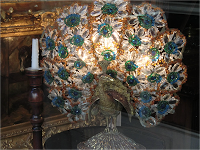 move along Royal Street, you really will find one-of-a-kind shops—the ones we really miss now in so much of the homogenized country and beyond.
move along Royal Street, you really will find one-of-a-kind shops—the ones we really miss now in so much of the homogenized country and beyond.Yes, many shops in Nola are filled with T-shirts and gadgets, trinkets, and souvenirs, but most are a little bit different and some are very different.
Some are for the casual tourist and some are for the connoisseur.
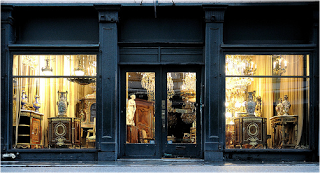 There are jewelry stores offering a fleur-di-lis motif on earrings, necklaces, and more, some commonplace and affordable, and some pretty pricey. There are high-end clothing shops and there are antique shops that offer everything from Civil War rifles, knives, buckles, and so on to exquisite furniture.
There are jewelry stores offering a fleur-di-lis motif on earrings, necklaces, and more, some commonplace and affordable, and some pretty pricey. There are high-end clothing shops and there are antique shops that offer everything from Civil War rifles, knives, buckles, and so on to exquisite furniture.You can shop for your kitchen. Buy charming aprons and barbecue implements or beignet mix, coffee—and lord knows! Hot sauce. Glass and china, fine wine, quirky bottle holders and can openers. Crawfish motifs can be seen almost as often as the fleur-de-lis. You can find the very elegant and the silly, risqué fun.
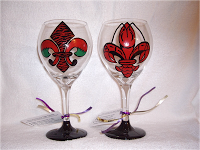
People who come to New Orleans often usually wind up having a few favorite shops—places where they have to stop because they don’t exist anywhere else. Some eagerly save and await their next chance to purchase an antique washstand or bowl or an exquisite piece of estate jewelry or newly created finery.
Art! There is incredible and fabulous art to be found. You don’t even need to go to a store—take a walk down Royal or around Jackson Square. You might snag a true treasure from an up and coming name—before they become a name!
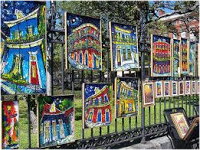 The galleries here are so fantastic, you could plan a day just looking at whats for sale in the shops and on Jackson Square and Royal Street.
The galleries here are so fantastic, you could plan a day just looking at whats for sale in the shops and on Jackson Square and Royal Street.So, of course, I have a few favorite shops of my own and in there, one that I never miss.
It isn’t a dress shop or clothing store or even an antique or a jewelry store or a gallery. My tastes tend to the slightly different.
Nola is so full of wonderful stores that I couldn’t begin to mention them all (though I will mention more as I move on with these blogs!) But there is one curious and wonderful shop that I—being me—must see when I’m in NOLA. It’s ever-changing. It’s a one-of-a-kind shop that doesn’t carry excellent New Orleans coffee, beignet mix, clothing, jewelry, antiques or Cajun spices hot enough to pull smoke from your head.
Fifi Mahoney’s. (934 Royal Street)
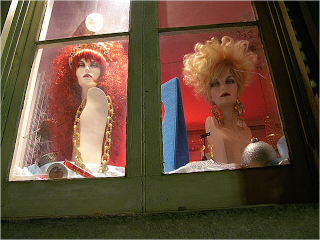 And first, of course, I don’t head right in. I look at their window displays because it’s almost like going to a little art show. What they do at Fifi’s with wigs is fun, enchanting, and uniquely Nola.
And first, of course, I don’t head right in. I look at their window displays because it’s almost like going to a little art show. What they do at Fifi’s with wigs is fun, enchanting, and uniquely Nola. I and my little group of merry Slushpile Players dress up fairly often to perform what may be defined as “something like dinner theater” or entertainment. We’ve done everything from spoofs of the latest rage in contemporary books or movies to the classics and beyond. So, when you’re looking for a really fine Mad Hatter Wig, crazy vampire wig . . . Mohawk, Oz, Steampunk-or-other wig, where do you head?
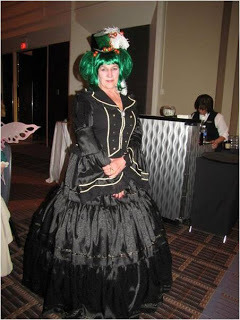
Fifi Mahoney’s.
First off, I should say, you can buy any kind of a wig here. From lesser materials and funky to a far higher quality. Just want to see what you’d look like with shorter hair, longer hair, darker hair, or light hair? You can do that here. Want to see what bangs would look like on you—or how you’d look with a Veronica Lake sweep of lock over your forehead? Yes, you can do that.
Were you ever dying to go chartrueuse? Perhaps wear a mock beehive, a ship, steamboat, or skulls dangling from ponytails? Yes, you can test it out at Fifi’s!
There are “normal” wigs, and then, of course, there are the designed wigs. Behind the artistry of the wigs here are the creators, Brian and Marci.
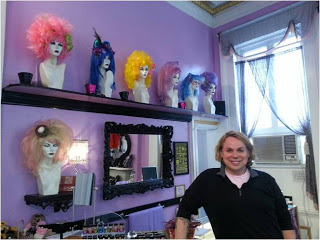
The two creative geniuses of the wig world have mastered the craft of making hair fun. Check out their web site. It’s fifimahoneys.com and you’ll see a few of their fantastic pieces. Entertainers from across the city (and the country!) come to them and when it gets close to Mardi Gras or Halloween, the place becomes a veritable madhouse of activity. While Mardi Gras may be celebrated in other exceptional forms across the world, say in Venice or Rio, few know the fervor as those who live in New Orleans. There are “krewes” to dress, kings and queens and royal courts, and if you don’t happen to be part of a krewe or on a float, you’re probably going to a party.
Few party with such flair—or such extravagant wigs! Many to most of these come from Fifi
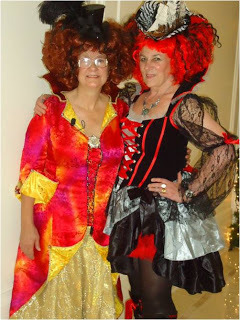 Mahoney’s.
Mahoney’s.For me, walking in and seeing their latest creations is always intriguing and I always find a fun, fantastic, or downright incredible wig that they’ve created and I feel that I must have.
But they’ll do custom as work as well. Dressing up for an occasion as a sprite or a fairy? You can have long flowing locks in any color of the rainbow threaded with flowers and leaves—and birds, if you so choose. Are you a gambler or a dance hall girl? Dice and cards can adorn your hair—along with poker chips and even a small slot machine, should you so choose!
Fifi Mahoney’s is on Royal Street, a nice walk if you happen to be staying at the beautiful and historic Hotel Monteleone—or anywhere. No visit is complete without a walk down Royal Street, which we’ll get to later.
Fifi’s carries all kinds of make-up, too, from the day to day to whacky lashes and brilliant colors for special events.
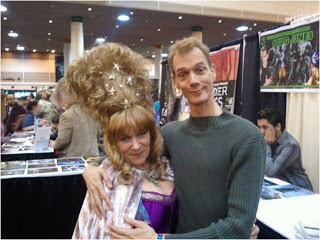
And fun, funky, jewelry, a lot of it locally created and some one-of-a-kind Fun hats!
And, if you’re fond of your own hair, you can have that taken care of too at the salon in the back.
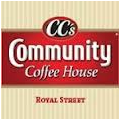 Say you’re in NOLA with someone else who is not in the least interested in hair or wigs. (It happens!) The 900 block of Royal has other cool and amazing shops and . . . a Community Coffee shop just across the street on the corner. To me, it’s a bit of seventh heaven—play at the wig shop, and stop in for Community Coffee. Their pecan-praline is to die for! (And I don’t even like flavored coffees!)
Say you’re in NOLA with someone else who is not in the least interested in hair or wigs. (It happens!) The 900 block of Royal has other cool and amazing shops and . . . a Community Coffee shop just across the street on the corner. To me, it’s a bit of seventh heaven—play at the wig shop, and stop in for Community Coffee. Their pecan-praline is to die for! (And I don’t even like flavored coffees!)
Published on March 27, 2013 22:56
Thirty Days of Why I Love New Orleans - Day 3
National World War II Museum and the Civil War Museum (Warehouse District) Where to begin? New Orleans is an amazing place to discover museums, big and small. It’s hard to figure out where to start. So, we’ll head to the World War II museum. In the scheme of things, it’s fairly new—but that doesn’t take away from the size. We were just there to check on a possible
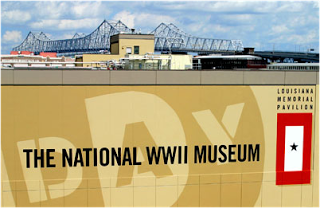 venue for opening ceremonies for a future con and I was amazed to see the construction going on! It will be absolutely huge. (945 Magazine Street, official address!) Huge, we all know, doesn’t mean good. But Nola’s WWII Museum is really both. It’s walking distance from the French Quarter and there’s decent parking when you’re coming from further afield. As the name implies, it tells the story of WWII. There are planes—there are tanks.
venue for opening ceremonies for a future con and I was amazed to see the construction going on! It will be absolutely huge. (945 Magazine Street, official address!) Huge, we all know, doesn’t mean good. But Nola’s WWII Museum is really both. It’s walking distance from the French Quarter and there’s decent parking when you’re coming from further afield. As the name implies, it tells the story of WWII. There are planes—there are tanks.  There are weapons, uniforms, and more. There are exhibits that grip your heart and don’t let go. Like so many venues in the city, the museum teaches us about the past and makes room for the living—and the future. Walking through the museum, I’m always in awe of the massive scope of what our nation went through and how we contributed and amazed by
There are weapons, uniforms, and more. There are exhibits that grip your heart and don’t let go. Like so many venues in the city, the museum teaches us about the past and makes room for the living—and the future. Walking through the museum, I’m always in awe of the massive scope of what our nation went through and how we contributed and amazed by 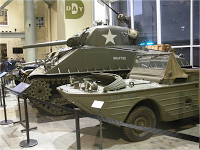 some of our allies, as well. I’m also drawn into the small and very human stories of the individual men and women who put their lives on the line. I came across a wonderful story about a Jewish woman who had been in a concentration camp—bound for the death chamber—who managed to escape right at war’s end. She was found hiding along the trail and was terrified at first. The man who found her was an
some of our allies, as well. I’m also drawn into the small and very human stories of the individual men and women who put their lives on the line. I came across a wonderful story about a Jewish woman who had been in a concentration camp—bound for the death chamber—who managed to escape right at war’s end. She was found hiding along the trail and was terrified at first. The man who found her was an 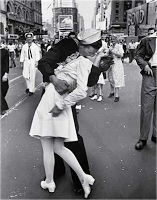 American soldier. Still frightened, she told him she was Jewish. He told her that he was Jewish, too. They wound up falling in love and marrying and they had a wonderful family and remained happy until his death at eighty-plus separated them.
American soldier. Still frightened, she told him she was Jewish. He told her that he was Jewish, too. They wound up falling in love and marrying and they had a wonderful family and remained happy until his death at eighty-plus separated them.The American Sector is a John Besh restaurant and the food is exceptional—and reminiscent of a bygone era as far as the seating, the ambiance, and the food goes. Soup served in tin cans and good old American fare, ice cream, fun stuff—and stuff for those with a healthful-eating life-style as well. Many entrees, naturally, have a bit of local flare, too. If you come to the museum, think about lunch or a cocktail. If you plan your trip, you can have “Dinner with a Curator” and become part of a discussion on specialized topics with a curator and fellow historians. Now, there’s a soda shop, too.
 You can see a movie at the Solomon Victory Theater, learn what you thought you knew but didn’t, and then listen to the Andrew Sisters inspired Victory Belles; they are great, trust me! You can catch any number of live shows at the Stage Door Canteen, see some of the stars of the era—those who fought, and those who performed for our troops. I’ve seen a tribute to Frank Sinatra there—the voices and performances were excellent. We rented the Canteen for an event once, too, and everyone involved was helpful and wonderful. They have a pretty decent web site if you want to check out times and what’s showing. Just remember—it’s big! They say you need three hours for the exhibits. You may also want to catch a show and a meal. (I dream some days about the soup and sandwich special!) The Civil War Museum is right across the street. (929 Camp Street) This museum opened in 1891 and houses one of the largest collections of Confederate
You can see a movie at the Solomon Victory Theater, learn what you thought you knew but didn’t, and then listen to the Andrew Sisters inspired Victory Belles; they are great, trust me! You can catch any number of live shows at the Stage Door Canteen, see some of the stars of the era—those who fought, and those who performed for our troops. I’ve seen a tribute to Frank Sinatra there—the voices and performances were excellent. We rented the Canteen for an event once, too, and everyone involved was helpful and wonderful. They have a pretty decent web site if you want to check out times and what’s showing. Just remember—it’s big! They say you need three hours for the exhibits. You may also want to catch a show and a meal. (I dream some days about the soup and sandwich special!) The Civil War Museum is right across the street. (929 Camp Street) This museum opened in 1891 and houses one of the largest collections of Confederate  memorabilia in the United States. I particularly love this museum not because I love war, but because I hate to see history forgotten in any way. The building is beautiful and the exhibits are fascinating and truly part of the American experience that makes us what we are today—still feuding within our states’ rights, but, hopefully, never to face such a tragedy again. Here, we see the great scope of things--all that led to our country’s “great divide.” But, more importantly, we see the war through the eyes of those who fought it. For military strategy buffs, there’s information on who made certain decisions, where plans
memorabilia in the United States. I particularly love this museum not because I love war, but because I hate to see history forgotten in any way. The building is beautiful and the exhibits are fascinating and truly part of the American experience that makes us what we are today—still feuding within our states’ rights, but, hopefully, never to face such a tragedy again. Here, we see the great scope of things--all that led to our country’s “great divide.” But, more importantly, we see the war through the eyes of those who fought it. For military strategy buffs, there’s information on who made certain decisions, where plans 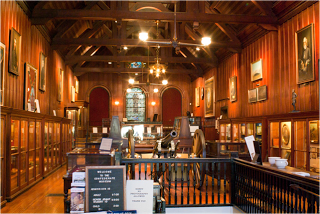 were brilliant, and where they went astray. Home life is an important part of the exhibition. And the tragedy that befell our nation becomes all the more evident as we see families torn apart; sons who faced their fathers, brothers who went to war against brothers. Some believed in the sanctity of the nation while others gave their first loyalty to the states. The issue of slavery is not ignored. But the realities are there, too. While the National World War II Museum is massive, the Civil War Museum is fairly small. Once again, size means little. It’s one of the best museums on the Confederacy and the “War of Northern Aggression” or the American Civil War you’ll ever see. (Yes, I was in school a while ago; there were still teachers telling it as such back then!) There are exhibits here that showcase Jefferson Davis, the one and only President of the Confederacy, and exhibits on the African-American fighting troops. Much to be seen and appreciated—as always, the tragedy of young men fighting and dying, each believing in his (or her, in a few instances!) cause until the true brutality of war sets in. The players in
were brilliant, and where they went astray. Home life is an important part of the exhibition. And the tragedy that befell our nation becomes all the more evident as we see families torn apart; sons who faced their fathers, brothers who went to war against brothers. Some believed in the sanctity of the nation while others gave their first loyalty to the states. The issue of slavery is not ignored. But the realities are there, too. While the National World War II Museum is massive, the Civil War Museum is fairly small. Once again, size means little. It’s one of the best museums on the Confederacy and the “War of Northern Aggression” or the American Civil War you’ll ever see. (Yes, I was in school a while ago; there were still teachers telling it as such back then!) There are exhibits here that showcase Jefferson Davis, the one and only President of the Confederacy, and exhibits on the African-American fighting troops. Much to be seen and appreciated—as always, the tragedy of young men fighting and dying, each believing in his (or her, in a few instances!) cause until the true brutality of war sets in. The players in 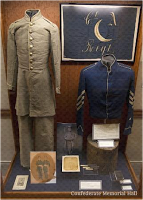 the great battle that nearly ripped us apart but then made us stronger are seen here—almost as if we were sitting down to tea with them. The thing is, museums teach us. That includes the good—and the bad and the ugly. But, they’re all about the human experience. I grew up in the South so I understand that the economy at the time dictated that the South held the majority of the slaves. I understand as well that some were treated poorly and some were treated well. None of that is the point that we all learned during the war—no man has the right to own another man. The majority of the soldiers fighting for the South did not own slaves—only 4.95 percent of men in the South did. Still, while the Federal government fought the war to preserve the Union, the South was fighting for “states’ rights” and an important right to the South was that to continue with slavery. But history can be strange, too—in New Orleans, men of African heritage sometimes owned other men of African heritage. We now know that no man of any color has any right to own any man of any color, but we learned it all in a very bloody bath. I’m grateful for this museum; it teaches. As I’ve said, we get to see things we did that were not moral; we also see more simply lives, wonderful human beings, and the confusion that will always be the human soul. Museums . . . we’ll deal with more later! If you have a chance, these two are excellent! As always, check opening dates and times if you want to go!
the great battle that nearly ripped us apart but then made us stronger are seen here—almost as if we were sitting down to tea with them. The thing is, museums teach us. That includes the good—and the bad and the ugly. But, they’re all about the human experience. I grew up in the South so I understand that the economy at the time dictated that the South held the majority of the slaves. I understand as well that some were treated poorly and some were treated well. None of that is the point that we all learned during the war—no man has the right to own another man. The majority of the soldiers fighting for the South did not own slaves—only 4.95 percent of men in the South did. Still, while the Federal government fought the war to preserve the Union, the South was fighting for “states’ rights” and an important right to the South was that to continue with slavery. But history can be strange, too—in New Orleans, men of African heritage sometimes owned other men of African heritage. We now know that no man of any color has any right to own any man of any color, but we learned it all in a very bloody bath. I’m grateful for this museum; it teaches. As I’ve said, we get to see things we did that were not moral; we also see more simply lives, wonderful human beings, and the confusion that will always be the human soul. Museums . . . we’ll deal with more later! If you have a chance, these two are excellent! As always, check opening dates and times if you want to go!
Published on March 27, 2013 09:13
Thirty Days of Why I Love New Orleans - Day 2
The Cemeteries Now, many people might start with Café du Monde. I do love Café du Monde and their café au lait, beignets and people watching across from Jackson Square, but this is me.
So we’re heading to the cemeteries.
First of all, many places in Louisiana have these “Cities of the Dead” so we’ll stay in the French Quarter and the Garden District. If you’re there and can only see one, it should be St. Louis
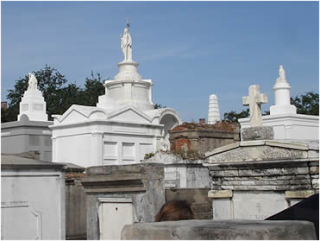 #1. It was the first of three St. Louis cemeteries. One, two, and three, go figure. But it’s here where you’ll find the tomb that some swear belongs to Marie LaVeau, the Voodoo Queen, and some say is not where her remains actually reside. She had a daughter named Marie, so who knows? But, it’s accepted that her home in the City of the Dead is at St. Louis #1 and while you’re not legally supposed to deface a tomb, there are Xs on it and you can place a penny on the ground and turn around three times for her to grant you blessings.
#1. It was the first of three St. Louis cemeteries. One, two, and three, go figure. But it’s here where you’ll find the tomb that some swear belongs to Marie LaVeau, the Voodoo Queen, and some say is not where her remains actually reside. She had a daughter named Marie, so who knows? But, it’s accepted that her home in the City of the Dead is at St. Louis #1 and while you’re not legally supposed to deface a tomb, there are Xs on it and you can place a penny on the ground and turn around three times for her to grant you blessings.

Never more does that term “decaying elegance” come more to mind than in the cemetery. Many of the vaults are still pristine and beautiful. Many are chipping and aged and create images of ghostly beings sweeping from tomb to tomb when dusk falls or when a mist rises.
St. Louis #1 was opened in 1789. Close by is St. Louis #2—by 1829, St. Louis #1 was already filled up—a horrible yellow fever epidemic had swept the city, speeding up the normal death rate. (In later years, room was made for some esteemed citizens of the city.) The Italian Society monument is the tallest and quite beautiful, as are other society vaults. Wrought iron surrounds some tombs; there are “oven” vaults in the walls, and just following the paths is fascinating as you discover just what interesting people found their eternal rest here. The classic cult film “Easy Rider” had scenes filmed here and the cemetery stars in a few other movies.
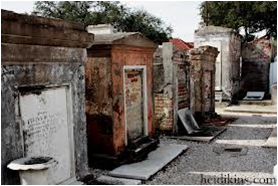
St. Louis #1 remains special to me for several reasons—it’s one of the first places I saw in Nola when I was a child and provided me with both nightmares and fascination ever since. The first year Connie Perry and I put on Writers for New Orleans—a workshop for writers that I host, at cost, just to bring money into the city after Katrina and the summer of storms—our friends who ran a carriage tour business brought our people here as one of the activities. It was so soon after the storm that the gates had not been locked at dusk and our group entered into the City of the Dead by night while our host told us history—true stories—more frightening than any ghost tale. I will never forget standing in the midst of the vaults beneath a half moon and thinking of the lives gone by—and appreciating life!
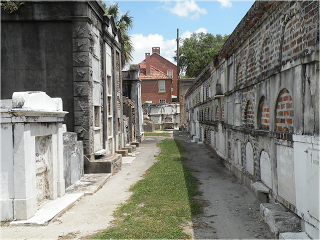
St. Louis #2 was built circa 1823 as an extension of #1 and can be found between Bienville and St. Louis Street, and between Claiborne Ave and N. Robertson Street. There are Creole tombs here along with stunning monuments, more wrought iron, more broken vaults. Many of the most beautiful and ornate tombs here were designed by a man named Jacques Nicholas Bussiere De Pouilly who had come from France. He loved the grandeur of the Pere Lachaise Cemetery outside of Paris and put his love of the artwork of the tombs there into his own creations.
St. Louis #3 can be found at 3421 Esplanade Avenue. It was opened in 1856, and is a distance from the other two cemeteries. It is remarkable as well with its statuary and monuments. While parts of Esplanade are exceptionally beautiful, the city and I both recommend that newcomers
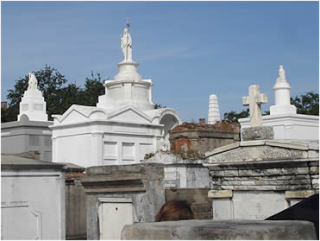 (and old comers!) go in groups or with specially designed tours. While Nola is one of our most unique and wonderful cemeteries, it is not without crime. Now, I’d say this if you were coming to Miami, too, New York, L.A., or just about anywhere; be careful where you go. Crime is a fact of life. That’s just the way it is.
(and old comers!) go in groups or with specially designed tours. While Nola is one of our most unique and wonderful cemeteries, it is not without crime. Now, I’d say this if you were coming to Miami, too, New York, L.A., or just about anywhere; be careful where you go. Crime is a fact of life. That’s just the way it is.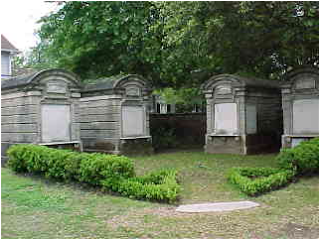 Heading to the Garden District you’ll find Lafayette Cemetery, peaceful and charming by day. It was laid out in 1833 to accommodate the residents of the Garden District. It was the second protestant cemetery to open in New Orleans. Confederate General Harry T Hays lies here along with many other notable luminaries. Fascinating and historic, Lafayette has great surroundings. From here, you can pop into the very wonderful Garden District Book Shop (2727 Prytania Street,) and perhaps dine at one of the city’s really wonderful restaurants, Commander’s Palace, right across from the cemetery entrance!
Heading to the Garden District you’ll find Lafayette Cemetery, peaceful and charming by day. It was laid out in 1833 to accommodate the residents of the Garden District. It was the second protestant cemetery to open in New Orleans. Confederate General Harry T Hays lies here along with many other notable luminaries. Fascinating and historic, Lafayette has great surroundings. From here, you can pop into the very wonderful Garden District Book Shop (2727 Prytania Street,) and perhaps dine at one of the city’s really wonderful restaurants, Commander’s Palace, right across from the cemetery entrance!Going beyond the French Quarter and the Garden District you’ll find Metairie Cemetery—certainly the most beautifully landscaped cemetery in the area. Walking among the trails of this vast cemetery is really akin to an afternoon at an art gallery—a pretty big gallery at that. It was opened in 1856 and the famous dead you’ll find here include Father Rouguette who was a missionary to the Choctaw and still esteemed for his acts of human kindness. You’ll see Metairie Cemetery
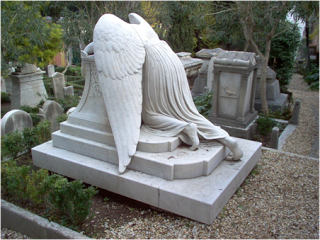 along the road as you travel into the city from the airport, and you’ll also catch glimpses of Cypress Grove Cemetery, established in 1841 by the Firemen’s Charitable Association. It offers an incredible Egyptian-style gate as one enters. Right across the street you’ll find Greenwood Cemetery—an extension of Cypress Grove. You just can’t make enough room for the eternally dying dead. It offers a Civil War Monument and many other excellent examples of funerary art.
along the road as you travel into the city from the airport, and you’ll also catch glimpses of Cypress Grove Cemetery, established in 1841 by the Firemen’s Charitable Association. It offers an incredible Egyptian-style gate as one enters. Right across the street you’ll find Greenwood Cemetery—an extension of Cypress Grove. You just can’t make enough room for the eternally dying dead. It offers a Civil War Monument and many other excellent examples of funerary art.Is it the art? Is it the continual wonder of what lies beyond? Is it just the way the moon falls over the tombs and angels and cherubs and crosses that guard the dead? There’s really no one answer or right answer; Nola’s cemeteries, the Cities of the Dead, are both fascinating and beautiful. They’ve given writers, artists, movie makers, and more endless resources upon which to draw. If you get to Nola, drop in on friends, enjoy the living—but don’t forget to visit the dead!
Published on March 27, 2013 00:00
March 26, 2013
Thirty Days of Why I Love New Orleans
Let the Dead Sleep
Thirty Days of Why I Love New Orleans
My book, Let the Dead Sleep , begins a series that highlights New Orleans. My protagonists--Danni Cafferty and Michael Quinn--are both from the city. They live and work in the city, love it, know it, and, naturally, want to keep it safe from harm!
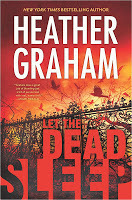
Well, I love the city, too. I've never lived there, but I spend a great deal of time there. I have since I was a small child.
So, today's "Why I Love" goes to the city itself.
New Orleans practices what I think of as living history daily. The French Quarter is filled with fantastic architecture—all being used today as restaurants, shops, hotels, homes, and what have you. While it's called the French Quarter, a lot of the architecture is actually
Spanish. That's because of the fires. But, I'm setting the mule before the carriage.
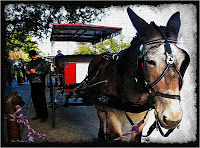 Native Americans lived in the area for hundreds of years before the first European explorers and fur traders began arriving in the late 1600s. 1718 brought the official founding of Nouvelle-Orléans by Jean-Baptiste Le Moyne de Bienville. In 1722 it became the capitol of French Louisiana, but a hurricane came and wiped out most of the houses that had existed at the time. They'd been described as hovels, so, maybe the hurricane—despite the damage and the horror—helped out history a bit. Because, after all that damage and horror, Bienville set about to create the grid that remains the boundary of the French Quarter or Vieux Carre today. In 1763, with the British victorious in the Seven Years War, the land was ceded to the Spanish--and thus the Spanish rule. That didn't work out so well--a lot of the settlers, no matter where they came from, wanted it all back under French Rule. They drove the Spanish governor out in the Bloodless Revolution.
Native Americans lived in the area for hundreds of years before the first European explorers and fur traders began arriving in the late 1600s. 1718 brought the official founding of Nouvelle-Orléans by Jean-Baptiste Le Moyne de Bienville. In 1722 it became the capitol of French Louisiana, but a hurricane came and wiped out most of the houses that had existed at the time. They'd been described as hovels, so, maybe the hurricane—despite the damage and the horror—helped out history a bit. Because, after all that damage and horror, Bienville set about to create the grid that remains the boundary of the French Quarter or Vieux Carre today. In 1763, with the British victorious in the Seven Years War, the land was ceded to the Spanish--and thus the Spanish rule. That didn't work out so well--a lot of the settlers, no matter where they came from, wanted it all back under French Rule. They drove the Spanish governor out in the Bloodless Revolution.
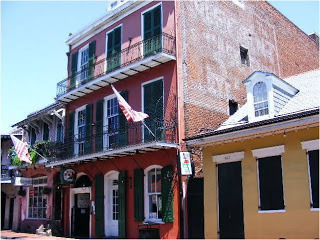
Ahha! The Spanish were not about to give up--a year later, they were back, and five of the ringleaders were executed and others were forced to pledge their loyalty to Spain. Next, great fires ripped through the city, the first being the Great New Orleans Fire of 1788 followed by another awful fire in December of 1794. Over a thousand buildings were destroyed.
After these fires--and while the Spanish were still in control--the city began to rebuild with brick. The cemetery, St. Louis #1, opened in 1789. While it’s true that flooding could cause bodies to float through the city, the style of the cemetery was, scholars argue, decidedly Spanish.
Rule got a little tricky and confusing. In 1795, the Spanish granted the United States "right of deposit." That meant the U.S. could use the port facilities. And then, in 1800 Spain and France signed the secret Treaty of San Ildefonso. It was so secret that many of the city’s residents wouldn’t know about it for years. It returned New Orleans to French rule, but only when the French were ready for a transfer of power and it wasn't to be for long. Then, as we know, Napoleon sold Louisiana (which included many other states or pieces of states!) to the United States.
By then, of course, the "English"--some real English and many Americans--were trickling in and there was a magnificent mixture of cultures and people.
However, from that time on, the beautiful city of New Orleans was American. Fantastic architecture was already in place and more was to come. The Garden District became part of the City of New Orleans back in 1833. Parcels of land were sold and since the “French” were in the Quarter, the “English” had to be somewhere. Both areas are unique, beautiful, and incredible.
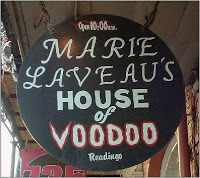 The Haitian Revolution that began in 1791 brought people—white and black, slave and free—to New Orleans and introduced incredible culture, including the Voodoo for which the city is so famous. Bad times were destined, of course. The Civil War came along, but the city was in the hands of the Union by 1862. And, as we all know, in our own day and age, the city was devastated by Katrina and the summer of storms and cast into further despair by the oil spill. But one thing about NOLA—the city is resilient! I was there yesterday and it was amazing to see the amount of people once again flocking the streets, making driving and walking a mad dash for survival, and most of all—appreciating the fantastic city.
The Haitian Revolution that began in 1791 brought people—white and black, slave and free—to New Orleans and introduced incredible culture, including the Voodoo for which the city is so famous. Bad times were destined, of course. The Civil War came along, but the city was in the hands of the Union by 1862. And, as we all know, in our own day and age, the city was devastated by Katrina and the summer of storms and cast into further despair by the oil spill. But one thing about NOLA—the city is resilient! I was there yesterday and it was amazing to see the amount of people once again flocking the streets, making driving and walking a mad dash for survival, and most of all—appreciating the fantastic city. My favorite description of the city as a whole is that which denotes her as “a gem of decaying elegance.” Now, trust me—not everything is decaying. There’s work constantly going on and many places are just plain elegant. Others are just plain fun. Some—like Lafitte’s Bar—lets you feel that you are, indeed, living history.
So, day one of loving New Orleans—she’s just a great city. There are all kinds of neighborhoods to visit extending beyond the French Quarter and the Garden District. There are the haunted cemeteries, the great Cities of the Dead, from St. Louis to Lafayette to those beyond the city limits. There is a bustling CBD, or Central Business District.
Oh, there are bayous and parks and national heritage sights and more. There is an excellent aquarium. There are so many places to go; there are carriage rides that must be taken, ghost tours, history tours, vampire tours!
The city, the beautiful city itself, is a gem. Just sit at Café Du Monde as others have since 1862 and watch the pageantry at Jackson Square or the abundance of people in the city as they pass by. See the beautiful buildings of Jackson Square, the cathedral, the Cabildo, the Presbytere . . . .
Ah. Those are for another day!
Published on March 26, 2013 06:44
July 27, 2012
Unusual Experience at Lizzie Borden's house
For me, places can be pure inspiration. And when they combine with workshops and friends, they are extra special.And so we come to an unusual experience at the Lizzie Borden Bed and Breakfast in Fall River, Massachusetts.
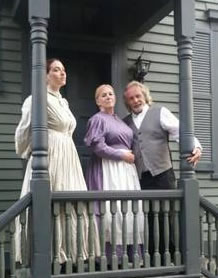
As a child growing up in Florida, I heard the rhyme often enough, especially playing jump rope. “Lizzie Borden took an axe and gave her mother forty whacks; when she saw what she had done, she gave her father forty-one.” Mr. Borden really got about fourteen whacks and Mrs. Borden a few more, but, hey, artistic license was at work.
I never thought at the time that I could so something so intriguing as actually spend the night in this house. Something that everyone can now do! It’s owned and run by Leeann Wilbur and a friend. Leeann has been painstaking in returning the home to its late nineteenth-century appearance, for it was August 4th, 1892, when the murders rocked Fall River—and the nation.
Every year, friends and I head to Necon—Northeastern Writers Conference—affectionately known as Camp Necon because it’s one of the warmest—and strangest!—cons ever. Writers and artists and film makers descend in small number—the con is cut-off at 200. But there are panels, art, books—and Saugie’s (hot dogs) on the quad by night. All deliciously creepy with horror stories and amazing art and a camaraderie that exists almost nowhere else.
And then, after Camp Necon, a group of us heads to the Lizzie Borden house.
So, this year, I was meeting videographers I’d never met before at the house to film a promo piece for upcoming books. I love Leeann—she has been wonderful to us!—and I rushed in after the last tour on our day to give her a hug and find out if the people there were “my” people.
But they were not. She was standing with a young woman and I realized I’d interrupted and I apologized and found out that she was the DP or design producer for another show being shot there for the Biography Channel. “Hey, they need a Lizzie,” Leeann told me. Hm. Well, since Chynna was with me, I laughed and said, “Hey, I think maybe I should be Abby—but have I got a Lizzie for you!”
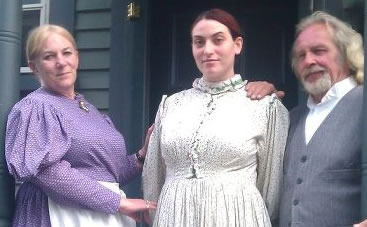
So I did wind up being Abby Borden, victim. This had its good—I didn’t need to lose weight since she had me about fifty pounds. In fact, the coroner had described her as “fleshy.” But we were set; Dennis Cummins, friend, writer, and amazing musician, was with us; he became my “husband” for the day, Andrew Borden. Corrinne de Winter was signed on to be a guest, and our little group set out to take part. The first day, my people did come and we filmed info on the house and interviews with our group. The next day . . . .
Roll out the blood!
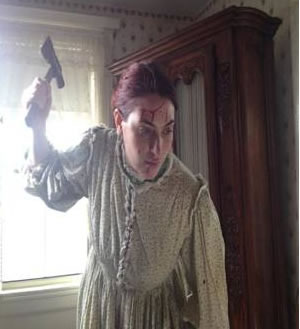
Now, some may think this strange. Here’s a family ready and happy for the daughter to whack away at the mother. But, then, we’ve always loved Poe and Lovelace and my children actually grew up in something like the Munster’s home, so—maybe not so strange. But, wrapped up in a dress that nicely added poundage I set out to straighten up the room while Chynna stalked me up the stairs. Historically and forensically, detectives and scholars through the years have determined that Abby did know her killer—she had no defensive wounds and surely didn’t know what was coming.
We used the hatchet that Leeann keeps in a woodbin in the kitchen. Chynna had to be careful—it says “Welcome” on one side.
The joke of the day with my family was that by the time the filming ended, I might actually know how to fold a blanket.
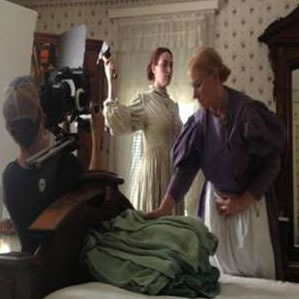
It takes time. I was whacked and whacked. I fell—right where Abby Borden was really found in what is now referred to as “the murder room.” I was asked if I was all right on the floor there—I was. Necon is one of those experiences that doesn’t really include sleep, so it was a nice little nap, really.
We spent a fair amount of time on what will boil down to a matter of seconds, and then I was free while Chynna went on to murder her “father.” For this, Brea, the production designer, gave me the task of tossing film blood all over Chynna. I mean, seriously, after being whacked all day, tossing a little blood back felt okay!
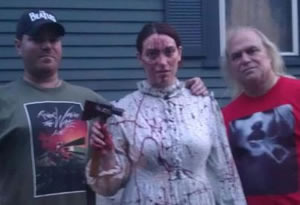
When we finally left, they’d gone to film their “ghost expedition.” The show will air in mid-October on Biography. That 220 “fleshy” person (she was also described as being ‘well-nutritioned’) on the floor will be me.
If you’ve always had a desire to do chilling things, get on over to Fall River Massachusetts. Google-search the Lizzie Borden Bed and Breakfast. Ask for the “Murder Room,” or sleep right where Lizzie herself did night after night. See if you can solve the age old questions—did she do it? Was there a conspiracy? Everyone has an opinion. But, whether you solve the crime or not, it’s a wonderful place to visit and stay. Tours—barring the unexpected—run daily except for Christmas and Thanksgiving.
But . . . .
Sleeping there, hm. That is fun. Hear the stories—and see if you see any of the haunts at Lizzie’s!
Published on July 27, 2012 11:19
July 26, 2012
Lizzie 40 Wacks and Necon
For me, places can be pure inspiration. And when they combine with workshops and friends, they are extra special.
And so we come to an unusual experience at the Lizzie Borden Bed and Breakfast in Fall River, Massachusetts.
As a child growing up in Florida, I heard the rhyme often enough, especially playing jump rope. “Lizzie Borden took an axe and gave her mother forty whacks; when she saw what she had done, she gave her father forty-one.” Mr. Borden really got about fourteen whacks and Mrs. Borden a few more, but, hey, artistic license was at work.
I never thought at the time that I could do something so intriguing as actually spend the night in this house. Something that everyone can now do! It’s owned and run by Leeann Wilbur and a friend.
Leeann has been painstaking in returning the home to its late nineteenth-century appearance, for it was August 4th, 1892, when the murders rocked Fall River—and the nation.
Every year, friends and I head to Necon—Northeastern Writers Conference—affectionately known as Camp Necon because it’s one of the warmest—and strangest!—cons ever. Writers and artists and film makers descend in small number—the con is cut-off at 200. But there are panels, art, books—and Saugie’s (hot dogs) on the quad at night. All deliciously creepy with horror stories and amazing art and a camaraderie that exists almost nowhere else.
And then, after Camp Necon, a group of us heads to the Lizzie Borden house.
So, this year, I was meeting videographers I’d never met before at the house to film a promo piece for upcoming books. I love Leeann—she has been wonderful to us!—and I rushed in after the last tour on our day to give her a hug and find out if the people there were “my” people.
But they were not. She was standing with a young woman and I realized I’d interrupted and I apologized and found out that she was the DP or design producer for another show being shot there for the Biography Channel. “Hey, they need a Lizzie,” Leeann told me. Hm. Well, since Chynna was with me, I laughed and said, “Hey, I think maybe I should be Abby—but have I got a Lizzie for you!”
So I did wind up being Abby Borden, victim. This had its good—I didn’t need to lose weight since she had me about fifty pounds. In fact, the coroner had described her as “fleshy.” But we were set; Dennis Cummins, friend, writer, and amazing musician, was with us; he became my “husband” for the day, Andrew Borden. Corrinne de Winter was signed on to be a guest, and our little group set out to take part. The first day, my people did come and we filmed info on the house and interviews with out group. The next day.... Roll out the blood!
Now, some may think this strange. Here’s a family ready and happy for the daughter to whack away at the mother. But, then, we’ve always loved Poe and Lovelace and my children actually grew up in something like the Munster’s home, so—maybe not so strange. But, wrapped up in a dress that nicely added poundage I set out to straighten up the room while Chynna stalked me up the stairs.
Historically and forensically, detectives and scholars through the years have determined that Abby did know her killer—she had no defensive wounds and surely didn’t know what was coming.
We used the hatchet that Leeann keeps in a woodbin in the kitchen. Chynna had to be careful—it says “Welcome” on one side.
The joke of the day with my family was that by the time the filming ended, I might actually know how to fold a blanket.
It takes time. I was whacked and whacked. I fell—right where Abby Borden was really found in what is now referred to as “the murder room.” I was asked if I was all right on the floor there—I was. Necon is one of those experiences that doesn’t really include sleep, so it was a nice little nap, really.
We spent a fair amount of time on what will boil down to a matter of seconds, and then I was free while Chynna went on to murder her “father.” For this, Brea, the production designer, gave me the task of tossing film blood all over Chynna. I mean, seriously, after being whacked all day, tossing a little blood back felt okay!
When we finally left, they’d gone to film their “ghost expedition.” The show will air in mid-October on Biography. That 220 “fleshy” person (she was also described as being ‘well-nutritioned’) on the floor will be me.
If you’ve always had a desire to do chilling things, get on over to Fall River Massachusetts. Google-search the Lizzie Borden Bed and Breakfast. Ask for the “Murder Room,” or sleep right where Lizzie herself did night after night. See if you can solve the age old questions—did she do it? Was there a conspiracy? Everyone has an opinion. But, whether you solve the crime or not, it’s a wonderful place to visit and stay. Tours—barring the unexpected—run daily except for Christmas and Thanksgiving.
But . . . .
Sleeping there, hm. That is fun. Hear the stories—and see if you see any of the haunts at Lizzie’s!
And so we come to an unusual experience at the Lizzie Borden Bed and Breakfast in Fall River, Massachusetts.
As a child growing up in Florida, I heard the rhyme often enough, especially playing jump rope. “Lizzie Borden took an axe and gave her mother forty whacks; when she saw what she had done, she gave her father forty-one.” Mr. Borden really got about fourteen whacks and Mrs. Borden a few more, but, hey, artistic license was at work.
I never thought at the time that I could do something so intriguing as actually spend the night in this house. Something that everyone can now do! It’s owned and run by Leeann Wilbur and a friend.
Leeann has been painstaking in returning the home to its late nineteenth-century appearance, for it was August 4th, 1892, when the murders rocked Fall River—and the nation.
Every year, friends and I head to Necon—Northeastern Writers Conference—affectionately known as Camp Necon because it’s one of the warmest—and strangest!—cons ever. Writers and artists and film makers descend in small number—the con is cut-off at 200. But there are panels, art, books—and Saugie’s (hot dogs) on the quad at night. All deliciously creepy with horror stories and amazing art and a camaraderie that exists almost nowhere else.
And then, after Camp Necon, a group of us heads to the Lizzie Borden house.
So, this year, I was meeting videographers I’d never met before at the house to film a promo piece for upcoming books. I love Leeann—she has been wonderful to us!—and I rushed in after the last tour on our day to give her a hug and find out if the people there were “my” people.
But they were not. She was standing with a young woman and I realized I’d interrupted and I apologized and found out that she was the DP or design producer for another show being shot there for the Biography Channel. “Hey, they need a Lizzie,” Leeann told me. Hm. Well, since Chynna was with me, I laughed and said, “Hey, I think maybe I should be Abby—but have I got a Lizzie for you!”
So I did wind up being Abby Borden, victim. This had its good—I didn’t need to lose weight since she had me about fifty pounds. In fact, the coroner had described her as “fleshy.” But we were set; Dennis Cummins, friend, writer, and amazing musician, was with us; he became my “husband” for the day, Andrew Borden. Corrinne de Winter was signed on to be a guest, and our little group set out to take part. The first day, my people did come and we filmed info on the house and interviews with out group. The next day.... Roll out the blood!
Now, some may think this strange. Here’s a family ready and happy for the daughter to whack away at the mother. But, then, we’ve always loved Poe and Lovelace and my children actually grew up in something like the Munster’s home, so—maybe not so strange. But, wrapped up in a dress that nicely added poundage I set out to straighten up the room while Chynna stalked me up the stairs.
Historically and forensically, detectives and scholars through the years have determined that Abby did know her killer—she had no defensive wounds and surely didn’t know what was coming.
We used the hatchet that Leeann keeps in a woodbin in the kitchen. Chynna had to be careful—it says “Welcome” on one side.
The joke of the day with my family was that by the time the filming ended, I might actually know how to fold a blanket.
It takes time. I was whacked and whacked. I fell—right where Abby Borden was really found in what is now referred to as “the murder room.” I was asked if I was all right on the floor there—I was. Necon is one of those experiences that doesn’t really include sleep, so it was a nice little nap, really.
We spent a fair amount of time on what will boil down to a matter of seconds, and then I was free while Chynna went on to murder her “father.” For this, Brea, the production designer, gave me the task of tossing film blood all over Chynna. I mean, seriously, after being whacked all day, tossing a little blood back felt okay!
When we finally left, they’d gone to film their “ghost expedition.” The show will air in mid-October on Biography. That 220 “fleshy” person (she was also described as being ‘well-nutritioned’) on the floor will be me.
If you’ve always had a desire to do chilling things, get on over to Fall River Massachusetts. Google-search the Lizzie Borden Bed and Breakfast. Ask for the “Murder Room,” or sleep right where Lizzie herself did night after night. See if you can solve the age old questions—did she do it? Was there a conspiracy? Everyone has an opinion. But, whether you solve the crime or not, it’s a wonderful place to visit and stay. Tours—barring the unexpected—run daily except for Christmas and Thanksgiving.
But . . . .
Sleeping there, hm. That is fun. Hear the stories—and see if you see any of the haunts at Lizzie’s!
Published on July 26, 2012 09:06
•
Tags:
heather-graham, lizzie-borden, necon, paranormal, thriller, unspoken
July 22, 2012
The Unseen, The Unholy, The Unspoken and The Uninvited
Writing the Krewe of Hunters—from the first book, Phantom Evil—has been an exceptionally fascinating undertaking.
I’m writing ghosts, so if you’re writing ghosts, you get to study ghosts!
Okay, it’s not exactly as if I can ask my friends if they know any ghosts I can interview, but in a way, it’s almost the same.
“My” ghosts actually began with a book called Haunted. Many more books came into being because of the elusive Adam Harrison. Adam had a son with a form of ESP and when his son, Joshua, died young and tragically, he passed his ESP on to a friend. And although Adam didn’t really have abilities himself, he recognized them in others and knew there was more to the world than what we see and feel.
Adam features (whether he’s actually in the pages or not) in Ghost Walk, Nightwalker, and several other books. (The Flynn Brothers Trilogy and the Keys Trilogy are not loosely related!)Because Adam has worked with the government helping out so often, it becomes evident that the Feds need some of the talent he knows all about.
Krewe of Hunters came into being with Jackson Crow charged with creating a unit of people with special talents. They all have something necessary for real law enforcement and then they’re . . . special. So began the first Krewe with Phantom Evil, Heart of Evil, Sacred Evil, and The Evil Inside.
But, it’s a big country. One unit was not enough. And so Jackson met with Texas Ranger Logan Raintree and U.S. Marshall Kelsey O’Brien and the Texas Krewe was born in The Unseen. I love the Alamo, so the research for The Unseen was eerie and wonderful—little seems as spectral and sacred as the Alamo in the late, quiet night. This place, to me, is incredibly important.
As it is in The Unholy—something truly fun and wonderful because of my friend, Michelle, who works for a major special effects studio and brought me through it, showing me horrific zombies and monsters—and giant rats for commercials and the little pig who goes “wee, wee, wee,” all the way home.
The Unholy is followed by The Unspoken which takes place in Chicago, a special city for me. It’s where my mom lived when she first came from Ireland and where my grandmother took me for candy and threatened me with banshees in the outhouse if I didn’t behave! She was a wonderful storyteller and also took me to the Field museum where I was terrified at a very young age by the mummies! Yes, mummies feature in The Unspoken along with the discovery of a long lost ship at the bottom of Lake Michigan.
The second Krewe tie it up with The Uninvited, once again taking place in a city I love dearly—Philadelphia. It’s the complete cradle of America, where our forefathers tread. When I’m there, I’m reminded that they signed their names—knowing it would mean death if they were taken as traitors by the British. They were lawyers, printers, and farmers—and they didn’t intend to spend their lives as politicians; they just wanted to create the country they dreamed could exist.
I love to walk around Independence Hall and imagine all that might have gone on at a time when our fate hung by a thread. In The Uninvited, mysterious deaths appear in a historic home where once upon a time a young woman was murdered, supposedly by the Brit who had taken her home hostage during the near-year when the patriots were forced to flee. Yes, she was spying, riding to Valley Forge . . . .
But what really happened? That’s a question that becomes intensely important as murders begin to occur in the present.
I sincerely loved working on these books. I hope you’ll love reading them.
Published on July 22, 2012 15:54
July 19, 2012
The Unseen, The Unholy, The Unspoken and The Uninvited
Writing the Krewe of Hunters—from the first book, Phantom Evil—has been an exceptionally fascinating undertaking.
I’m writing ghosts, so if you’re writing ghosts, you get to study ghosts!
Okay, it’s not exactly as if I can ask my friends if they know any ghosts I can interview, but in a way, it’s almost the same.
“My” ghosts actually began with a book called Haunted. Many more books came into being because of the elusive Adam Harrison. Adam had a son with a form of ESP and when his son, Joshua, died young and tragically, he passed his ESP on to a friend. And although Adam didn’t really have abilities himself, he recognized them in others and knew there was more to the world than what we see and feel.
Adam features (whether he’s actually in the pages or not) in Ghost Walk, Nightwalker, and several other books. (The Flynn Brothers Trilogy and the Keys Trilogy are not loosely related!)Because Adam has worked with the government helping out so often, it becomes evident that the Feds need some of the talent he knows all about.
Krewe of Hunters came into being with Jackson Crow charged with creating a unit of people with special talents. They all have something necessary for real law enforcement and then they’re . . . special. So began the first Krewe with Phantom Evil, Heart of Evil, Sacred Evil, and The Evil Inside.
But, it’s a big country. One unit was not enough. And so Jackson met with Texas Ranger Logan Raintree and U.S. Marshall Kelsey O’Brien and the Texas Krewe was born in The Unseen. I love the Alamo, so the research for The Unseen was eerie and wonderful—little seems as spectral and sacred as the Alamo in the late, quiet night. This place, to me, is incredibly important.
As it is in The Unholy—something truly fun and wonderful because of my friend, Michelle, who works for a major special effects studio and brought me through it, showing me horrific zombies and monsters—and giant rats for commercials and the little pig who goes “wee, wee, wee,” all the way home.
The Unholy is followed by The Unspoken which takes place in Chicago, a special city for me. It’s where my mom lived when she first came from Ireland and where my grandmother took me for candy and threatened me with banshees in the outhouse if I didn’t behave! She was a wonderful storyteller and also took me to the Field museum where I was terrified at a very young age by the mummies! Yes, mummies feature in The Unspoken along with the discovery of a long lost ship at the bottom of Lake Michigan.
The second Krewe tie it up with The Uninvited, once again taking place in a city I love dearly—Philadelphia. It’s the complete cradle of America, where our forefathers tread. When I’m there, I’m reminded that they signed their names—knowing it would mean death if they were taken as traitors by the British. They were lawyers, printers, and farmers—and they didn’t intend to spend their lives as politicians; they just wanted to create the country they dreamed could exist.
I love to walk around Independence Hall and imagine all that might have gone on at a time when our fate hung by a thread. In The Uninvited, mysterious deaths appear in a historic home where once upon a time a young woman was murdered, supposedly by the Brit who had taken her home hostage during the near-year when the patriots were forced to flee. Yes, she was spying, riding to Valley Forge . . . .
But what really happened? That’s a question that becomes intensely important as murders begin to occur in the present.
I sincerely loved working on these books. I hope you’ll love reading them.
The Unspoken
I’m writing ghosts, so if you’re writing ghosts, you get to study ghosts!
Okay, it’s not exactly as if I can ask my friends if they know any ghosts I can interview, but in a way, it’s almost the same.
“My” ghosts actually began with a book called Haunted. Many more books came into being because of the elusive Adam Harrison. Adam had a son with a form of ESP and when his son, Joshua, died young and tragically, he passed his ESP on to a friend. And although Adam didn’t really have abilities himself, he recognized them in others and knew there was more to the world than what we see and feel.
Adam features (whether he’s actually in the pages or not) in Ghost Walk, Nightwalker, and several other books. (The Flynn Brothers Trilogy and the Keys Trilogy are not loosely related!)Because Adam has worked with the government helping out so often, it becomes evident that the Feds need some of the talent he knows all about.
Krewe of Hunters came into being with Jackson Crow charged with creating a unit of people with special talents. They all have something necessary for real law enforcement and then they’re . . . special. So began the first Krewe with Phantom Evil, Heart of Evil, Sacred Evil, and The Evil Inside.
But, it’s a big country. One unit was not enough. And so Jackson met with Texas Ranger Logan Raintree and U.S. Marshall Kelsey O’Brien and the Texas Krewe was born in The Unseen. I love the Alamo, so the research for The Unseen was eerie and wonderful—little seems as spectral and sacred as the Alamo in the late, quiet night. This place, to me, is incredibly important.
As it is in The Unholy—something truly fun and wonderful because of my friend, Michelle, who works for a major special effects studio and brought me through it, showing me horrific zombies and monsters—and giant rats for commercials and the little pig who goes “wee, wee, wee,” all the way home.
The Unholy is followed by The Unspoken which takes place in Chicago, a special city for me. It’s where my mom lived when she first came from Ireland and where my grandmother took me for candy and threatened me with banshees in the outhouse if I didn’t behave! She was a wonderful storyteller and also took me to the Field museum where I was terrified at a very young age by the mummies! Yes, mummies feature in The Unspoken along with the discovery of a long lost ship at the bottom of Lake Michigan.
The second Krewe tie it up with The Uninvited, once again taking place in a city I love dearly—Philadelphia. It’s the complete cradle of America, where our forefathers tread. When I’m there, I’m reminded that they signed their names—knowing it would mean death if they were taken as traitors by the British. They were lawyers, printers, and farmers—and they didn’t intend to spend their lives as politicians; they just wanted to create the country they dreamed could exist.
I love to walk around Independence Hall and imagine all that might have gone on at a time when our fate hung by a thread. In The Uninvited, mysterious deaths appear in a historic home where once upon a time a young woman was murdered, supposedly by the Brit who had taken her home hostage during the near-year when the patriots were forced to flee. Yes, she was spying, riding to Valley Forge . . . .
But what really happened? That’s a question that becomes intensely important as murders begin to occur in the present.
I sincerely loved working on these books. I hope you’ll love reading them.
The Unspoken

Published on July 19, 2012 11:36
•
Tags:
heather-graham, hunters, krewe, paranormal, romance, sexy, thrller
June 8, 2012
A Travel Whirlwind
I’m writing this at the tail end of the BEA—initials that stand for Booksellers Expo of the Americas.
It’s fantastic. Hundreds—no, maybe thousands?—of authors are there with their publishers or organizations such as Mystery Writers of America, Romance Writers of America—horror writers and sci-fi writers—come out to sign books. And give them away.
It’s a reader’s smorgasbord. It’s a chance to meet people.
And it’s a great chance to have fun with friends.
It’s also New York City.
Now, I admit I’m ready to go home.
But . . . .
The last three months have been a whirlwind of travel for me, a lot it work, some of it for family, and, thankfully, a lot in which work and family could combine. I’ve been back and forth from Miami, Bowling Green, L.A., New York, Nashville, Orlando, Dallas, New Orleans, Houma, Covington, San Antonio, Atlanta, Las Vegas, and Chicago.
But when I think about going home, I get to think, too, about the places I’ve been. And I’m kind of amazed, thinking of how much is out there and what a spectacular land this is. In the Nashville area, I was enchanted by the beauty of the country; in Kentucky, I was bowled over by the charm and hospitality of the people. Las Vegas was sheer fun—the kind I probably shouldn’t have all that often! If you know me or about me, you know I love New Orleans and the history there; Chicago offers Second City comedy and architecture and the grandeur of Lake Michigan.
Who can really hate Mickey Mouse? (Okay, I have, at times. You know—when you’ve been standing in ninety-degree heat for an hour or so with a ride with a bunch of hungry, impatient, and thirsty kids! But, in general, I love the artistry—and the pool at the Dolphin hotel!)
San Antonio is beautiful—and the Alamo is spiritual and the way they light it up at night, it’s a misty feeling of the past that is an eerie reminder of all that happened there.
In California, thanks to friends Scott and Sprout of the Peace River Ghost Hunters, I had a really unique experience with an investigation on the Queen Mary.
In all this, of course, there are deadlines. So, I have gotten really good at whipping my computer out in a plane, on a train . . . if it’s in the rain . . . whatever! And a friend asked me once just how I was getting work done and I thought that yes, it was difficult.
But, I realized I was grateful, too. I was reminded of just how fantastic I found so many places in our country; I met wonderful people—from whom I will steal when creating characters. I’ve been enriched by incredible experiences—which I will use, too, of course.
And now, on that plane going home (I really do miss my pets! My little nephews, family, and friends when I’m gone, though, luckily, I’ve had family members with me on different legs of this long and eclectic trip!). Thanks to BEA, I’m going to have some really great reading material!
It’s fantastic. Hundreds—no, maybe thousands?—of authors are there with their publishers or organizations such as Mystery Writers of America, Romance Writers of America—horror writers and sci-fi writers—come out to sign books. And give them away.
It’s a reader’s smorgasbord. It’s a chance to meet people.
And it’s a great chance to have fun with friends.
It’s also New York City.
Now, I admit I’m ready to go home.
But . . . .
The last three months have been a whirlwind of travel for me, a lot it work, some of it for family, and, thankfully, a lot in which work and family could combine. I’ve been back and forth from Miami, Bowling Green, L.A., New York, Nashville, Orlando, Dallas, New Orleans, Houma, Covington, San Antonio, Atlanta, Las Vegas, and Chicago.
But when I think about going home, I get to think, too, about the places I’ve been. And I’m kind of amazed, thinking of how much is out there and what a spectacular land this is. In the Nashville area, I was enchanted by the beauty of the country; in Kentucky, I was bowled over by the charm and hospitality of the people. Las Vegas was sheer fun—the kind I probably shouldn’t have all that often! If you know me or about me, you know I love New Orleans and the history there; Chicago offers Second City comedy and architecture and the grandeur of Lake Michigan.
Who can really hate Mickey Mouse? (Okay, I have, at times. You know—when you’ve been standing in ninety-degree heat for an hour or so with a ride with a bunch of hungry, impatient, and thirsty kids! But, in general, I love the artistry—and the pool at the Dolphin hotel!)
San Antonio is beautiful—and the Alamo is spiritual and the way they light it up at night, it’s a misty feeling of the past that is an eerie reminder of all that happened there.
In California, thanks to friends Scott and Sprout of the Peace River Ghost Hunters, I had a really unique experience with an investigation on the Queen Mary.
In all this, of course, there are deadlines. So, I have gotten really good at whipping my computer out in a plane, on a train . . . if it’s in the rain . . . whatever! And a friend asked me once just how I was getting work done and I thought that yes, it was difficult.
But, I realized I was grateful, too. I was reminded of just how fantastic I found so many places in our country; I met wonderful people—from whom I will steal when creating characters. I’ve been enriched by incredible experiences—which I will use, too, of course.
And now, on that plane going home (I really do miss my pets! My little nephews, family, and friends when I’m gone, though, luckily, I’ve had family members with me on different legs of this long and eclectic trip!). Thanks to BEA, I’m going to have some really great reading material!
Published on June 08, 2012 21:35
•
Tags:
bea, heather-graham
A Travel Whirlwind
I’m writing this at the tail end of the BEA—initials that stand for Booksellers Expo of the Americas. It’s fantastic. Hundreds—no, maybe thousands?—of authors are there with their publishers or organizations such as Mystery Writers of America, Romance Writers of America—horror writers and sci-fi writers—come out to sign books. And give them away. It’s a reader’s smorgasbord. It’s a chance to meet people. And it’s a great chance to have fun with friends. It’s also New York City. Now, I admit I’m ready to go home. But . . . .The last three months have been a whirlwind of travel for me, a lot it work, some of it for family, and, thankfully, a lot in which work and family could combine. I’ve been back and forth from Miami, Bowling Green, L.A., New York, Nashville, Orlando, Dallas, New Orleans, Houma, Covington, San Antonio, Atlanta, Las Vegas, and Chicago. But when I think about going home, I get to think, too, about the places I’ve been. And I’m kind of amazed, thinking of how much is out there and what a spectacular land this is. In the Nashville area, I was enchanted by the beauty of the country; in Kentucky, I was bowled over by the charm and hospitality of the people. Las Vegas was sheer fun—the kind I probably shouldn’t have all that often! If you know me or about me, you know I love New Orleans and the history there; Chicago offers Second City comedy and architecture and the grandeur of Lake Michigan. Who can really hate Mickey Mouse? (Okay, I have, at times. You know—when you’ve been standing in ninety-degree heat for an hour or so with a ride with a bunch of hungry, impatient, and thirsty kids! But, in general, I love the artistry—and the pool at the Dolphin hotel!) San Antonio is beautiful—and the Alamo is spiritual and the way they light it up at night, it’s a misty feeling of the past that is an eerie reminder of all that happened there. In California, thanks to friends Scott and Sprout of the Peace River Ghost Hunters, I had a really unique experience with an investigation on the Queen Mary. In all this, of course, there are deadlines. So, I have gotten really good at whipping my computer out in a plane, on a train . . . if it’s in the rain . . . whatever! And a friend asked me once just how I was getting work done and I thought that yes, it was difficult. But, I realized I was grateful, too. I was reminded of just how fantastic I found so many places in our country; I met wonderful people—from whom I will steal when creating characters. I’ve been enriched by incredible experiences—which I will use, too, of course. And now, on that plane going home (I really do miss my pets! My little nephews, family, and friends when I’m gone, though, luckily, I’ve had family members with me on different legs of this long and eclectic trip!). Thanks to BEA, I’m going to have some really great reading material!
Published on June 08, 2012 14:02



